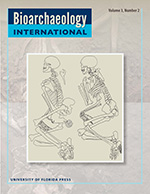Stable Isotope Analysis of Human Diet at Chelechol ra Orrak, Palau
Main Article Content
Abstract
Stable isotope studies of early human populations in Remote Oceania, the last major region to be settled by humans, have the potential to shed light on our understanding of dietary adaptations to small island environments. However, little research has focused on western Micronesia, which was settled ca. 3500–3000 cal B.P., contemporaneous with the better-known Lapita culture. Human skeletal remains recovered from three archaeological sites in Palau, Micronesia, dating between ca. 3000 and 1500 cal B.P., were tested for light stable isotope ratios to determine patterns of paleodiet. Results from bone collagen of 23 samples are characterized by moderately high δ15N values (avg. 11.4‰) and δ13C values (avg. –14.8‰), reflecting significant consumption of marine protein resources. Bone apatite δ13C values (avg. –7.3‰) suggest consumption of 13C-enriched dietary carbohydrates, which could potentially include seaweed or sugarcane. Results correspond well with complementary archaeological evidence, demonstrating that early Palauans were heavily dependent on marine food resources and are similar to contemporary Lapita groups, suggesting that endemic marine resources were critical to successful colonization of these small, remote island environments.
Aika el kmal mlo uriul el beluu el ng mlo er ngii a delengchokl er ngii, a omesubir a rechad er a mesechesechel a beluu er a taiheio el ousbech a kar el isotope, a ngar er ngii a techellel el meskid e klemedengei er kid e kirel a kall el lulenga a rechad er aika el iungs. E ng di kekere el omesuub a mla mo er ngii, el kuk kmal di melutk el kirel a iungs er a ngebard er a Micronesia el mlo er ngii a delengchokl er ngii er a bekord ede el telael me a eim el dart el mo er a ede el telael el rak, (3500–3000 BP) el ngii el taem a kmal di mengaisisu er a temel se el merael a chisel Lapita Culture (uchelir a rechad er a taiheio el bekai er tir a le biltik er ngii er a Lapita el beluu er a New Caledonia). Tia el babier a mo mesaod a chiuesir a rechad el mlengai er a klde el basio er a beluu er a Belau el mirrael a ureor er ngii el kirel a chuodel el delengchokl, el rekil a ngar er a delongelel a ede el telael mo ta el telael me a eim el dart el rak (3000–1500 BP) e mlengai el mo er a skeng el ousbech a kar el isotope el mo omeketakl a teletelel a omengelir a rechad er a rechuodel.
Me a skeng el mlegai er a lluich me a klde el ngerdel a chiuis a mlo meketeklii el kmo ng telkib er a bab δ15N values (avg. 11.4‰) me a δ13C values (avg –14.8‰) el ngii a ochotii el kmo a omengelir a rechad a kmal mle klou el utluil er a kall el mengai er a daob. A skeng er a bedengel a chiuis δ13C values (avg –7.3‰) a ochotii el kmo omengelel el kall el mui er a 13C a ochotii el kmo kall el lulenga tirka el chad a locha mlengai er a dellomel el uldimukl er ngii a char me a lechub e ng deb.

